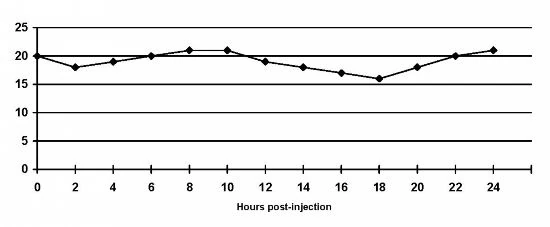Insulin resistance refers to a body's inability to use normal amounts of insulin. There is more than one cause of insulin resistance -- the most commonly mentioned by vets is that due to an autoimmune disorder. Insulin resistance can show up when your pet is newly diagnosed, shortly after diagnosis, or some time after this.
Instead of using the insulin, the immune system chooses to view it as something foreign, and it is attacked by antibodies. This is much like how one's body works at defending itself from a cold or flu. The resistance can appear any time the body has decided to reject the insulin. [1][2]
Since technically, the insulin one injects is viewed by the body as something other than its own, there will be some degree of resistance to it in the form of antibodies. This becomes a problem when 70% or more of the injected insulin is rendered ineffective due to antibody binding. [3]
Antibodies [4] which are not present to the degree of resistance above, can mean slower onset and peak of insulin, with a longer duration. Bovine insulin is 3 amino acids removed from a perfect match to native human insulin; beef Ultralente has a longer duration than Lantus in people.
The Axiom Labs article linked below [5] defines autoimmune insulin resistance as requiring a dose > (greater than) 2.2 iu/kg--more than 2.2 units per 2.2lb of body weight at a single dose. [6] Animal Medicine Center of New York defines it as pronounced hyperglycemia throughout the day when insulin dosages are greater than 1.5 iu/kg per shot. [7] Other definitions available are based on units per pound but are unclear regarding whether it means total amount of insulin given in a day or per dose. These two using kilograms leaves no doubt regarding that it is on a per dose basis.
It is also possible to have symptoms of insulin resistance where the resistance is not directed at the insulin itself, but rather at other proteins present in its composition. [8] Insulins which are either protamine-suspended or Protamine Zinc (PZI) all contain protamine, which is also a protein. It's therefore possible to have an immune reaction to the suspension. Changing to a suspension not containing protamine should solve this.
What insulin resistance looks like--this animal is being treated with twice daily Lente insulin injections (Species of animal & insulin not stated). Note: the blood glucose measurements are in mmol/l (non-US) values.

Insulin resistance is also known as Insulin antagonism.
Other causes[]
- Overweight is linked in humans to insulin resistance, though the mechanisms are not fully understood. Obese cats and dogs [9] also display a degree of insulin resistance, also known as a lack of insulin sensitivity, due to obesity, [10] which may in turn, in some cases, lead to diabetes. [11][12]
In the case of dogs, losing weight is helpful with reducing the resistance, but will not cause reversion to non-diabetic status or permit transfer from insulin injection to oral medications.
- Glucose toxicity, the cell-destructive effects of hyperglycemia, can cause a temporary form of insulin resistance which may make a pet appear unresponsive to insulin shots.
- Medications Some medications have side effects of raising blood glucose. [13] There's a list of them at the link.
- Cushing's disease, an overproduction of cortisol which constantly raises blood sugar. [14]
- Recurrent infections [15] will cause the body to raise blood sugar as part of an immune response.
References[]
- ↑ Insulin-Precautions & Side Effects. PetPlace.com.
- ↑ Richards, Mike. Insulin use in Dogs-Insulin Antibodies. Richards, Mike-Vet Info 4 Dogs.
- ↑ Brooks, Wendy C.. The Hard to Regulate Diabetic Dog. Veterinary Partner.
- ↑ Bruyette, David (2001). Diabetes Mellitus: Treatment Options. WSAVA.
- ↑ Ristic, Jelina. The Difficult Diabetic. Axiom Labs.
- ↑ Pounds to Kilograms/Kilograms to Pounds online converter. Open Toronto.
- ↑ Peterson, ME. (1995). Diagnosis & Management of Insulin Resistance in Dogs & Cats With Diabetes Mellitus. Veterinary Clinics of North America-Small Animal Practice.
- ↑ Vetsulin-Problems With Regulation-Antibodies. Intervet.
- ↑ Caninsulin-Typical Concurrent Problems Causing Insulin Antagonism. Intervet.
- ↑ German AJ, Hervera M, Hunter L, Holden SL, Morris PJ, Biourge V, Trayhurn P. (2009). Improvement in insulin resistance and reduction in plasma inflammatory adipokines after weight loss in obese dogs. Domestic Animal Endocrinology.
- ↑ Vetsulin-Insulin Resistance & Obesity. Intervet.
- ↑ Jerico, Marcia Marquez (2009). Metabolic Syndrome and Dyslipidemia in Dogs. WSAVA.
- ↑ Richards, Mike. Insulin use in Dogs-Insulin Resistance. Richards, Mike-Vet Info 4 Dogs.
- ↑ Richards, Mike. Insulin use in Dogs-Insulin Resistance-Cushing's Disease. Richards, Mike-Vet Info 4 Dogs.
- ↑ Poeppl, AG., Mueller, F., Queiroga, L., Oliveira, I. (2009). Insulin Resistance Due to Periodontal Disease in an Old Diabetic Female Poodle. WSAVA.
- ↑ Ford SL, Nelson RW, Feldman EC, Niwa D. (1993). Insulin Resistance in Three Dogs with Hypothyroidism and Diabetes Mellitus. Journal of the American Veterinary Association.
More Information[]
- Vetsulin-Insulin Requirement Changes in Dogs Intervet
- Vetsulin-FAQs Intervet
- Vetsulin-Insulin Control-Insulin Resistance Intervet
- Identifying the reasons behind difficult-to-control diabetes in dogs Cook, Audrey, 1 April 2010, DVM 360